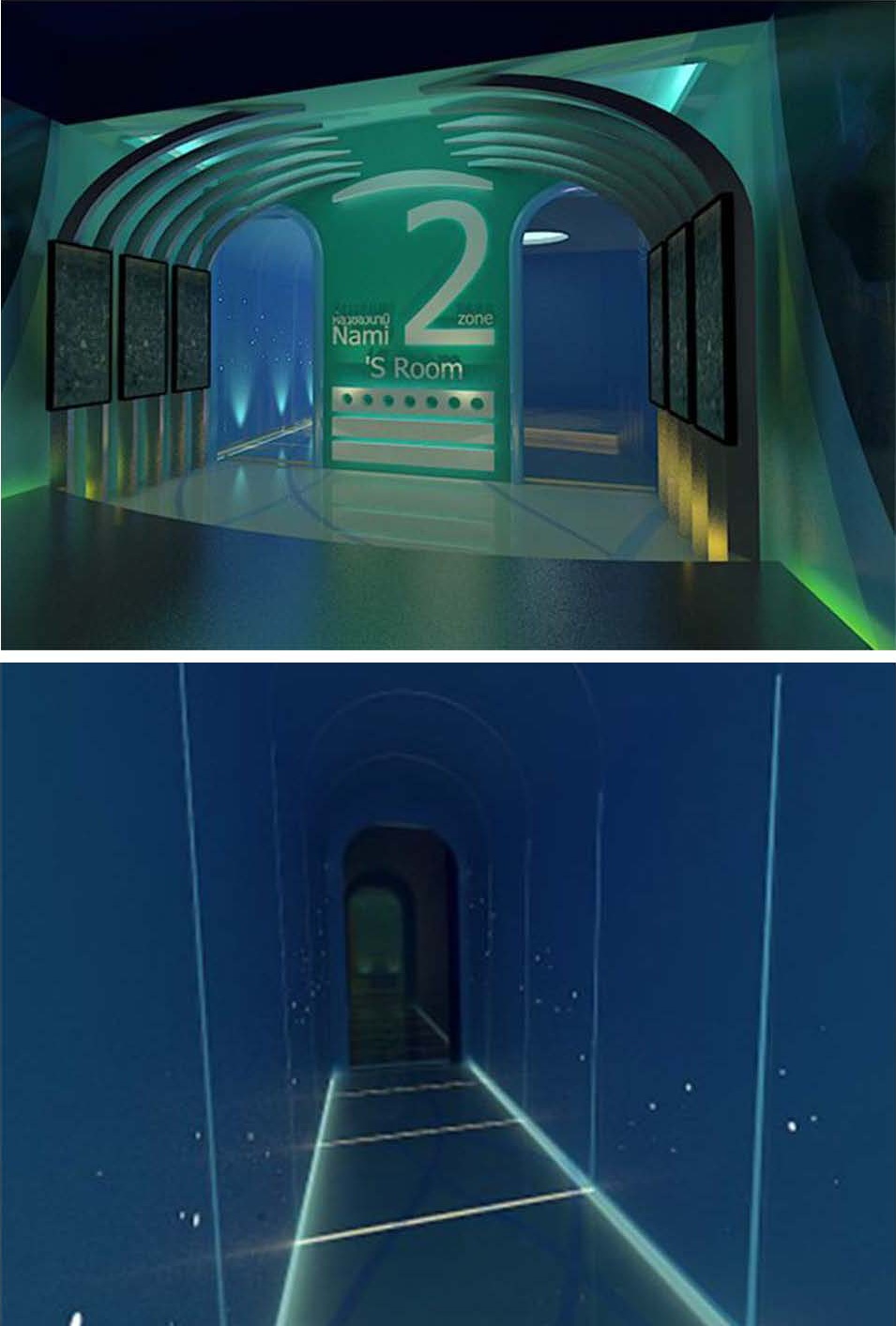การออกแบบนิทรรศการเสมือนจริง เพื่อสนับสนุนการเรียนรู้จากการปฏิสัมพันธ์ระหว่างมนุษย์กับนิทรรศการ
คำสำคัญ:
นิทรรศการเสมือนจริง, การรับรู้, การปฏิสัมพันธ์ระหว่างมนุษย์กับนิทรรศการ, ผู้เยี่ยมชมนิทรรศการบทคัดย่อ
การวิจัยนี้มุ่งศึกษาปัจจัยในการสื่อสารงานนิทรรศการ จากการผสมผสานการสร้างนิทรรศการและเทคโนโลยีใหม่ เพื่อเพิ่มประสบการณ์ผู้ชมงานในเชิงบวก ลักษณะงานวิจัยเป็นการวิจัยเชิงคุณภาพร่วมกับการวิจัยเชิงปริมาณ เครื่องมือในการวิจัย ประกอบด้วย แบบสัมภาษณ์เชิงลึก จากกลุ่มตัวอย่างที่เป็นตัวแทนผู้เชี่ยวชาญ 3 กลุ่ม เพื่อทราบถึงปัจจัยในการออกแบบนิทรรศการเสมือนจริง และแบบสอบถาม ผ่านทางออนไลน์ ควบคู่กับแบบจำลองนิทรรศการเสมือนจริง 3 มิติ เพื่อทดสอบการรับรู้ของผู้เยี่ยมชมนิทรรศการ ผลการวิจัย พบว่า ปฏิกิริยาที่เกิดจากการเยี่ยมชมงานนิทรรศการสามารถแบ่งออกเป็น 2 ประเภท ได้แก่ การรับรู้และอารมณ์ วิธีการออกแบบการจัดแสดงที่มีประสิทธิภาพต้องอยู่บนพื้นฐานของหลักการออกแบบ และต้องอาศัยปัจจัยที่เกี่ยวข้องกับการออกแบบ เช่น การตกแต่ง สื่อหรือเทคโนโลยี ความสัมพันธ์เชิงพื้นที่ ประสิทธิภาพของแสง และวัสดุในการตกแต่ง ส่วนปัจจัยอื่น ๆ
เช่น วัตถุจัดแสดง ข้อความที่จะสื่อสาร อิทธิพลทางกายภาพ สุนทรียศาสตร์ สี อิทธิพลทางสังคม จัดเป็นกลยุทธ์ที่
ใช้ในการส่งเสริมการรับรู้ของมนุษย์ด้วยเช่นกัน อีกทั้งนักออกแบบต้องให้ความสำคัญกับประเด็นหลัก 5 ประเด็น ประกอบด้วย ประเด็นด้านเนื้อหา ประเด็นด้านภาษา ประเด็นด้านการใช้งาน และประเด็นด้านการออกแบบ เพื่อให้งานนิทรรศการเสมือนจริงที่ออกแบบนั้นบรรลุเป้าหมายตามที่นักออกแบบตั้งวัตถุประสงค์ไว้
References
Alt, M.B., et al. (1988). The design of educational exhibits (2nd Eds). London: Routledge and CRC Press.
Baker, J. (1987). The role of the environment in marketing services: the consumer perspective. In Czepiel, J., Congram, C. & Shanahan, J. (Eds.). The services challenge: integrating for competitive advantage. (pp.79–84). Chicago: American Marketing Association.
Bitgood, S. & Patterson, D. (1987). Principles of exhibit design. Visitor Behavior, 2(1), 4–6.
Bitgood, S. & Patterson, D. (1993). The effects of gallery changes on visitor reading and object viewing time. Environment and Behavior, 25(6), 761-781.
Bitgood, S., Patterson, D. & Benefield, A. (1988). Exhibit design and visitor behavior: empirical relationships. Environment and Behavior, 20(4), 474-491.
Bonis, B., et al. (2007). Personalization of content in virtual exhibitions. Proceedings of the Second International Conference on Semantic and Digital Media Technologies (SAMT) 2007 (pp.172-184). Heidelberg: Springer.
Charitos, D., et al. (2000). An approach to designing and implementing virtual museums. Proceedings of the 7th UK VR-SIG Conference (pp.1-8). Glasgow: n.p.
Charitos, D., et al. (2001). Designing a virtual museum within a museum. Proceedings of the 2001 Conference on Virtual Reality, Archeology, and Cultural Heritage (pp.1-8). New York: Association for Computing Machinery (ACM).
Chuan, C.H., et al. (2006). A new communication model in the natural history museum. Proceedings of the 2006 meeting of INTERCOM (pp.1-27). Taipei: n.p.
Deckers, E., et al. (2012). Designing for perceptual crossing: applying and evaluating design notions. International Journal of Design, 6(3), 41–55.
Falk, J.H. & Dierking, L.D. (2000). Learning from museums: visitor experiences and the making of meaning. California: AltaMira Press.
Forrest, R. (2013). Museum atmospherics: the role of the exhibition environment in the visitor experience. Visitor Studies, 16(2), 201-216.
Francis, D.K.C. & Binggeli, C. (2018). Interior design illustrated (4th Eds). New York: John Wiley & Sons Inc.
Garrett, J.J. (2011). The elements of user experience: user-centered design for the web and beyond (2nd Eds). California: New Riders.
Melton, A.W. (1972). Visitor behavior in museums: some early research in environmental design. Human Factors, 14(5), 393-403.
Moona, H.S., Kima, J.K. & Ryu, Y.U. (2013). A sequence-based filtering method for exhibition booth visits recommendations. International Journal of Information Management, 33(4), 620–626.
Peart, B. (1984). Impact of exhibit type on knowledge gain, attitudes, and behavior. Curator, 27(3), 220-237.
Praphruetdi, P. (2019). Karn nam sanoe theknoloyi samueanching nai phiphitthaphan silapa. (In Thai) [The use of virtual reality in art museum]. Humanities, Social Sciences and arts, 12(3), 1104-1118.
Van Bueren, E.M. (2009). Greening governance: an evolutionary approach to policy making for a sustainable built environment. Netherlands: IOS Press.
Wolfgang, F.E.P., Rabinowitz, H.Z. & White, E.T. (1988). Post-occupancy evaluation. New York: Van Nostrand Reinhold.

Downloads
เผยแพร่แล้ว
ฉบับ
บท
License
Copyright (c) 2022 คณะสถาปัตยกรรมศาสตร์ มหาวิทยาลัยเชียงใหม่

This work is licensed under a Creative Commons Attribution-NonCommercial-NoDerivatives 4.0 International License.



